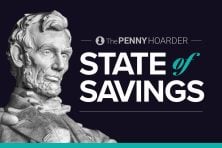What Is Stagflation and How It Affects You

We’re seeing the word “stagflation” popping up more these days. Economists are concerned it’s coming, experts are giving advice on combating it and businesses are adjusting their strategies to prepare. But the word isn’t exactly something we hear every day, so it’s only natural to stare at headlines, wondering, “What is stagflation, really?”
Understanding stagflation is key to protecting yourself during economic uncertainty. Let’s break down what it means, why it happens and what you can do about it.
What Is Stagflation? A Simple Definition
You might have guessed it already, but stagflation combines two words: stagnation and inflation. In this case, “what is stagflation?” refers to a stagnant economy, and inflation relates to rising prices. When the economy is thriving, inflation is usually inevitable. Consumers have more money to spend, so prices go up. But when the economy begins to struggle, prices tend to drop to reflect spending habits.
Stagflation flips the script. The economy is slowing down, but inflation continues, making things tough on consumers. Joseph Camberato, CEO at NationalBusinessCapital.com, compares stagflation to being stuck in the mud.
“The economy’s not falling off a cliff, but it’s not growing either, and prices are still going up,” Camberato explains. “So you’ve got high inflation, but the economy isn’t moving. It’s just kind of…stuck. You’re not seeing job growth or big gains in business, but your grocery bill keeps climbing. That’s stagflation.”
Worried About Stagflation? Make Some Extra Cash
We don’t blame you if the idea of stagflation has you nervous. Though we aren’t there yet, wouldn’t we all feel a bit better with some extra cash flow? Check out some of our favorite ways to make easy money.
| Offer | What You Can Earn | What You Have to Do | Take Action |
|---|---|---|---|
| InboxDollars | $225/month | Complete short surveys | |
| FreeCash | $1,000/month | Simple online tasks | |
| GoBranded | Up to $140/month | Share your honest opinion | |
| Kashkick | $1,000/month | Try out apps | |
| Solitaire Cash | Up to $83 per win | Compete against other players | |
| Bingo Cash | Up to $83 per win | Compete against other players |
What Causes Stagflation?
While stagflation is rare, it does happen. Typically, a combination of factors leads to the economic anomaly. Stagflation causes include:
1. Supply Shocks
When something shifts in the supply chain, it can affect things down the line. Prices go up even as economic activity is slowing down.
“If the cost of something essential (like energy) suddenly skyrockets, everything that depends on it — transportation, manufacturing, food — gets more expensive,” said Brian Lawrence, CFA, partner and financial advisor at North Ridge Wealth Advisors.
2. Poor Economic Policy
Government action can directly impact the economy. Even a small economic change can lead to runaway inflation without the job growth to support it.
“Sometimes governments try to stimulate the economy (like printing more money or keeping interest rates too low for too long),” Lawrence explains. “But if supply can’t keep up, it just makes prices rise faster. Or, like recently, high tariffs are swiftly imposed, and they distort the global economy.”
3. Global Instability
Stagflation doesn’t just come from U.S.-based causes. Overseas wars, global pandemics and geopolitical tensions can disrupt trade, as well as supply chains, leading to a dangerous combination of inflation and economic slowdowns.
4. Labor Market Disruptions
The labor market also directly affects the economy. If businesses struggle to find workers, productivity can decline, causing prices to increase regardless of how the economy is performing.
How Stagflation Affects Your Everyday Life
Now that we’ve answered, “What is stagflation?” here’s how it affects consumers on a day-to-day basis:
- Higher prices at the grocery store
- Increasing fuel costs
- Stagnant or falling wages
- Rising interest rates
- Lower investment returns
- Increased financial stress
“Think of it like your wallet’s shrinking while life gets pricier,” Camberato said.
While all of this may seem grim, if we are headed for stagflation, knowledge is power. The more you understand about it and how it might impact your bank account, the better you can prepare.
What is Stagflation and Its History in the U.S.
The biggest modern example of stagflation in the U.S. came in the 1970s during a period known as The Great Inflation. Inflation began rising in the 1960s, peaking at just over 14% in 1980. During the same timeframe, unemployment rose from 5% in 1964 to 7.5% in 1980.
As Dr. Brandon Parsons, economist at Pepperdine Graziadio Business School, explains, stagflation originated with the oil crisis, caused by the Organization of the Petroleum Exporting Countries significantly boosting the price of oil overnight.
“Because oil is a key input in transportation, manufacturing and energy, the increase in oil prices rippled through the U.S. economy, raising costs for businesses and households,” Dr. Parsons said. “The increase in oil prices led to stagflation, high inflation and a recession.”
Those who lived through the economic crisis remember long lines for gas, skyrocketing prices for basic groceries and the constant fear of becoming unemployed. It was during this time that mortgage rates hit their highest point to date, reaching 18.44% in 1981.
How to Protect Your Finances During Stagflation
Guarding your finances is always a great idea, but during periods of stagflation, it’s essential. Here are a few things you can do when preparing for stagflation:
- Build (or rebuild) your emergency fund
- Lock in low interest rates
- Trim nonessential expenses
- Explore additional income streams
- Use budgeting tools
- Review your subscriptions
High-yield savings accounts and CDs can be a great way to protect yourself against stock market turbulence while also taking advantage of high interest rates.
“Stay calm, not frozen or frantic,” Lawrence advises. “Fear makes us want to do something — anything! But often, the best move is to pause, reflect and act intentionally.”
Should You Change Your Investment Strategy?
Investing during economic turmoil can put you on an emotional rollercoaster. But you can also take advantage of lower stock prices if you have a little extra money. During periods of stagflation, diversification is key.
If you’re going to continue to invest, though, consider stagflation-resistant investments. Here are a few options:
- Commodities: During stagflation, investments like metals, agricultural products and oil tend to hold steady.
- Treasury Inflation-Protected Securities (TIPS): The government offers TIPS as a way to protect consumers against inflation. You can buy them in 5-, 10- or 30-year terms.
- Dividend-paying stocks: When the economy turns iffy, some savvy investors put their funds into company shares. The company, in turn, issues regular payments as a thank-you for investing.
- Real estate: With housing prices on the rise, 2025 is a great time to buy property. Even if the market dips, real estate tends to naturally appreciate over time, making it more reliable than the stock market.
“Long-term investment strategies should probably be tilting more to tangible assets like real estate and precious metals and away from ‘paper’ assets,” Mariano Torras, PhD, and professor of finance and economics at Adelphi University, recommends.
Staying Financially Resilient in Tough Times
Stagflation may be rare, but it can hit your finances hard when it does happen. The good news is, it’s not permanent. By taking a proactive approach, you can reduce the hit you’ll take during any kind of economic turbulence. Whether it’s cutting costs, building savings or tweaking your investment strategy, some small changes can make a big difference.
Stephanie Faris is a professional finance writer with more than a decade of experience. Her work has been featured on a variety of top finance sites, including Money Under 30, GoBankingRates, Retirable, Sapling and Sifter.












